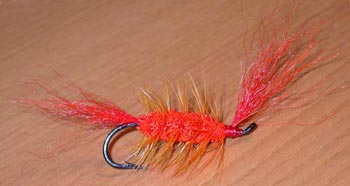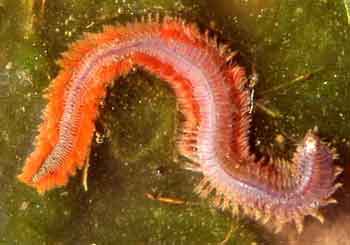 |
 |
||||||||||||
I have tied many different flies to take stripers when they are selectively feeding on mating Nereis worm (clam/cinder worms) swarms. Basically the color of these small worms is in the red spectrum ranging from an orangy brown to a reddish pink. Red is also the part of the color spectrum striped bass see the best. Since this fly is fished in the surface the fish can discern the color well and will reject it if the color is not what it desires, even on the darkest new moon night. Empirical evidence leads me to think, at least for now, that red works on new moons and orange on full moons. Of course this evidence comes from fishing both red and orange to find out which one would work. Fishing this pattern in both orange and red throughout the summer, over many nights, under both moons, the stripers never took red on the full moons or orange on new moons. I am not writing that in stone because next year it might change. I fished them mostly by dead drifting over as long a drift as I could or I slightly skating them. Both ways drew hits. This image shows an orange bomber using orange thread, hot orange calftail and orange hackle and orange spun deer hair on a #4 salmon hook. The red bomber uses red thread, calftail, hackle and spun deer hair. I also tied one using Fiery Orange spun deer hair and did not draw a hit. The main difference between a salmon/steelhead bomber and my striper version is I trim the deer hair as close as possilbe to resemble the worm profile. |
Time of Appearance: several days around the new moon and full moon. Night is best with the top of outgoing to the bottom. One night I was fishing with a friend. We were fishing three days before a new moon at around 8 pm and just before the outgoing current began to pick up. At first we were only aware of an enormous amount of silversides. Their jumping sounded like rain as I waded through the water. In addition, there were also a great deal of grass shrimp. There were also gnats eating our faces off. It was also very warm and muggy that night. We were both working silverside patterns. But as the bass were busting the surface our lines were light. As each quarter hour passed the noise of busting fish grew. It was so crazy that my friend and I couldn't stop laughing. It was really nuts. Yet we weren't catching anything. At one point, as I was changing my fly I saw a cinder worm in the water with my headlight. I took one and made a rough measurement: 1½". I yelled to my buddy, "Cinder worms!" "Oh, shit!" he said. I asked him if he had anything to use. He did. He had some red Gartside Gurlers with long red bucktails. I put one of my worm flies on and caught a bass. I then told my friend to chop his fly down to 1½". He did and he began to catch more than I was. The gnats were horrible and drove my friend home but he left me one of his flies. I chopped it to the correct length and caught a couple of stripers. But I was NOT satisfied with the results. The next day I contacted a friend and I described to him how the swarm went down and I asked him if he thought it would happen the following night. He said definitely yes and gave me explicit directions on how to deal with it. What I learned was that the fly I was using was fine. It was the right size and had nice life to it. I ended up tying some different flies that were closer to what I had observed. The problem lay in feeling the many almost imperceptible hits that were going unnoticed. Either I didn't feel them and/or I was pulling the fly out of the bass's mouth without knowing it. In addition to the 1½" hot orange General Practioner fly I planned to use I was advised to attach a float about 10" above the fly to keep it high in the water column for the entire drift. The key however was how to control the line through out the drift. What was critical was to keep an absolute tight line by constantly retrieving it, not stripping but taking up slack. The second piece of advice was how to set the hook. The stripers (and large shad too!) were inhaling these worms but I guess were not alwaus moving away and the hook would just come out of their mouths. However, when the slightest interference in the line was felt I was instructed to not set the hook but to hold the line tight and as tension grew on the line to match it by gradually adding pressure with my line hand. It worked well. I got down there that night an hour later (9 pm) and left at 1:30am. I wasn't able to get down to the water for the next couple of days but I did find another worm swarm four days before the next new moon and had the similar positive results. It ended up being the best fishing of the year. Coloration: Hot orange, orange, red, pinks and violets. |